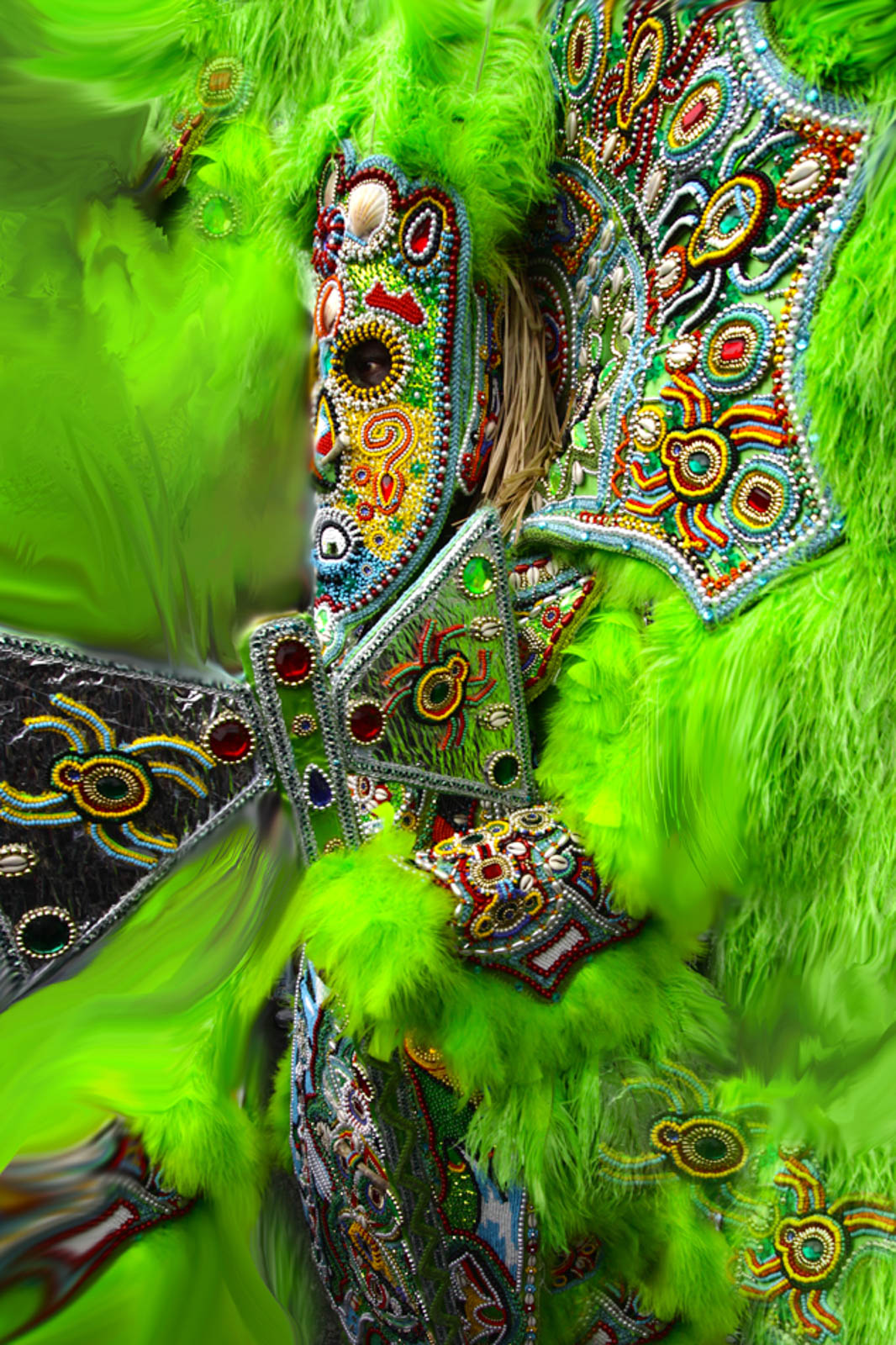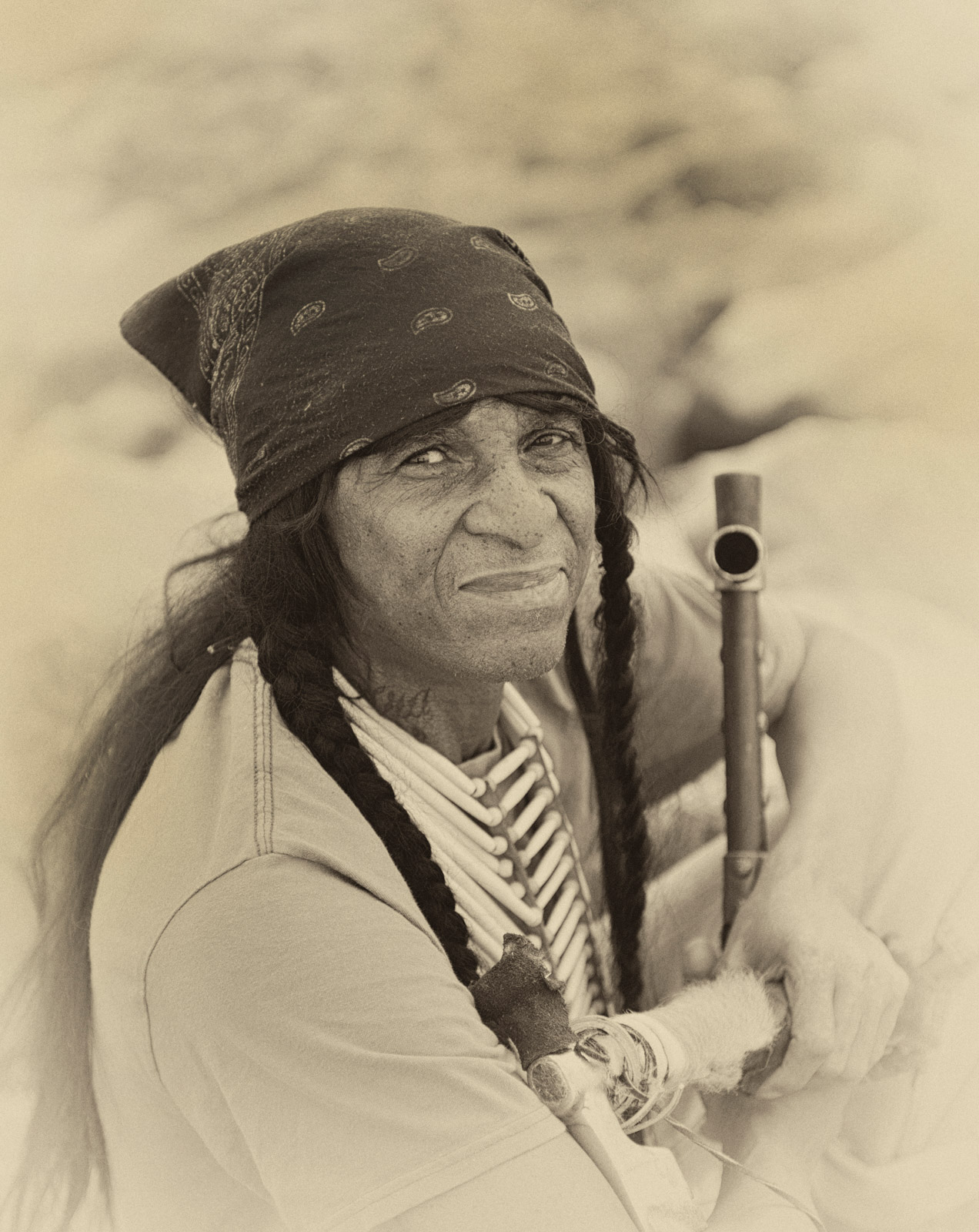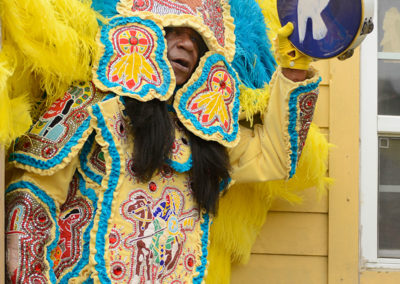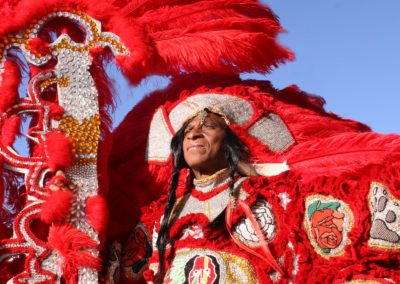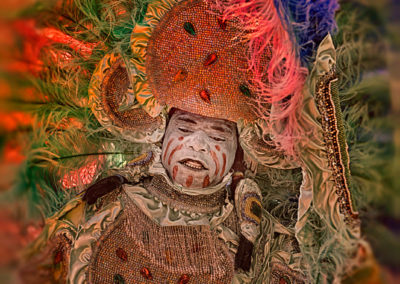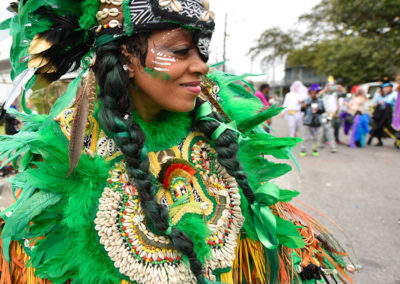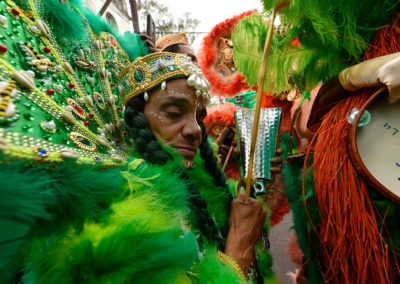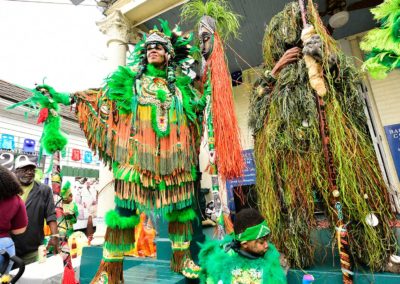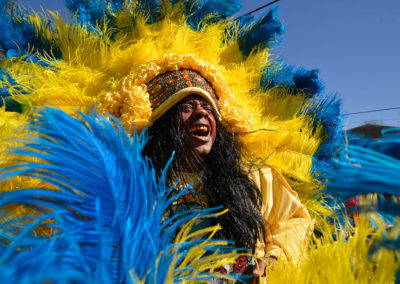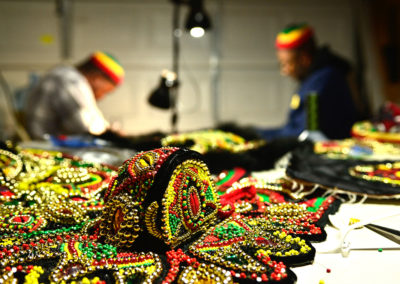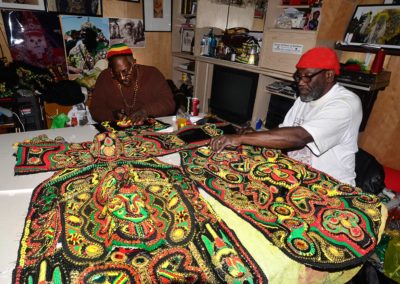Once shrouded in secrecy, with little interest in sharing their traditions with the outside world, Black Masking Indians, also known as Mardi Gras Indians, have become celebrated icons whose music draws Grammy nominations and whose history and folkways command serious attention from scholars and media outlets, documentary filmmakers and major cultural institutions.
The multicultural soul of New Orleans
Big Chief Victor Harris on Mardi Gras 2011
When he puts on his suit and hits the street with his tribe, people hear the “Fi Yi Yi” chant and come running as if to receive a blessing.
Photo by Lisa DuBois
Since 1970, when they appeared at the inaugural New Orleans Jazz and Heritage Festival, Mardi Gras Indians, also known as Black Masking Indians, have emerged from the relative obscurity of neighborhood backstreets to become celebrated icons, with their music and folkways emblazoned on the cultural consciousness of New Orleans and beyond. Eyeball-popping costumes or “suits” by the likes of Demond Melancon of the Young Seminole Hunters and Victor Harris of the Mandingo Warriors, Spirit of Fi Yi Yi are now featured in prestigious art exhibitions. And even before the HBO series Tremé, in which Black Indians figured prominently, helped bring the culture to a mass audience, scholars and media outlets, documentary filmmakers and major cultural institutions had shown a steady uptick in interest in Big Chiefs and their tribes.
There was a time, mostly before World War II, when some people would run from the Indians because they raised a frightful ruckus; tribes sometimes skirmished on the “battlefield” with actual weapons. When legendary Chief Allison “Tootie” Montana became immersed in the tradition in the late 1940s, the practitioners were like a secret society. They had little interest in sharing their traditions with the outside world and attracted only a handful of admirers from beyond the predominantly Black, working-class communities that had sustained the culture as a living, and continually evolving, art form since the 1800s. Montana, of the Monogram Hunters tribe and later the Yellow Pocahontas, would become the most celebrated Black Indian of all time, credited with having played a pivotal role in transforming rivalries between tribes into aesthetic competition and with demonstrating a level of mastery and dedication that seemed to know no limits.
With the release of commercial recordings of their music and regular appearances at the Jazz and Heritage Festival, the emergence of Black Indians as revered culture bearers began to gain traction. Maurice Martinez’s The Black Indians of New Orleans documentary, released in 1976, pulled back the veil for a wider audience. The film touched on origins and documented barroom practice and Mardi Gras rituals, focusing on the Yellow Pocahontas and White Eagles tribes. Tootie Montana and White Eagles Chief Gerald “Jake” Millon spoke on-camera, giving the project an insider perspective and credibility.
Still, even into the 1980s, the Indians were basically a curiosity in the eyes of the local tourism and media establishment. Those who “masked” Indian didn’t seek validation from such quarters, and images of their pageantry and sartorial brilliance didn’t figure into marketing campaigns celebrating the city’s heritage. Then in 1987, after being nominated by Martinez, Montana became the first Black Indian to be awarded a National Heritage Fellowship by the National Endowment for the Arts. (Theodore Emile “Bo” Dollis of the Wild Magnolias received the award, considered the nation’s top honor in folk and traditional arts, in 2011, and Joseph Pierre “Big Chief Monk” Boudreaux of the Golden Eagles followed suit in 2016.)
Montana was greeted by a massive throng when he came out on Mardi Gras for his golden anniversary in 1997. That summer, the New Orleans Museum of Art stepped up with the exhibition He’s the Prettiest: A Tribute to Big Chief Allison “Tootie” Montana’s Fifty Years of Mardi Gras Indian Suiting. It was the first time Mardi Gras Indian regalia had ever been displayed at the prestigious museum.
Big Chief Lil Walter Cook
His Choctaw lineage has always made him feel more deeply connected to the Mardi Gras Indian tradition, while also inspiring him to craft regalia from materials procured from Native tribes including bones, porcupine quills, deer hair and turkey tails.
Photo by Lisa DuBois
Although the question of when the first “tribe” took to the streets on Mardi Gras is contested, it’s generally understood that masking Indian on Mardi Gras grew out of colonialism and its byproduct — slavery — which made it inevitable that Louisiana’s African and Indian cultures would intersect in ways that would shape history. People of African descent adopting the Indian persona was simultaneously an act of homage to Native Americans who gave sanctuary to runaways; a symbolic expression of ritual freedom and resistance to the shared experience of subjugation; and a means of summoning ancestral spirts and of channeling and preserving African traditions. At a time when racial barriers prevented their participation in Carnival activities staged by the dominant culture, Mardi Gras Indians took to the backstreets in the guise of proud, thrill-seeking warriors. Their refusal to surrender dignity found expression in the saying “Won’t bow down, don’t know how.”
The history of masking Indian is further complicated by the extensive intermingling of Black and Native bloodlines in Louisiana. The cultures have blended in ways that aren’t always appreciated when, for example, questions arise about whether Mardi Gras Indians unjustly appropriate Native folkways, imagery and tribal names.
Tootie Montana had African and Native blood. Cornelius “Brother” Tillman of the Creole Wild West tribe, who made a name for himself masking Indian in the first half of the 20th century, looked more Indian than African. “Lil Walter” Cook became chief of the Creole Wild West, generally regarded as the oldest Mardi Gras tribe, in 1976, at age 16, and held the position until 2018. His maternal grandmother was a full-blooded Choctaw. Boudreaux of the Golden Eagles counts both Choctaw and Cherokee among his ancestors.
Some who carry on the tradition identify more with African precursors, none more so than Harris. Departing from the open-face crowns traditionally worn by those who mask Indian — a style derived from Native Americans — he wears stunning, Malian-style masks that completely cover his head. (His suit designs are also notable for their use of shells and grass.) The origins of his tribe date to 1984, when a spirit (Fi Yi Yi) came into his life as a force of healing and protection. When he puts on his suit and hits the street — singing and chanting as drumbeats echo and tambourines shake — the Big Chief becomes Fi Yi Yi. And when people hear “Fi Yi Yi,” they come running as if to receive a blessing.
The chants, rhythmic syncopations and freely improvised singing of the Indians, as culture critic Howard Reich has pointed out, predated the invention of jazz music and helped lay the groundwork for “a freewheeling, African-inspired music that differed radically from the straitlaced classic symphonies and high-flown operas of Europe.” Boudreaux stands out as an acclaimed elder who has enjoyed a prolific musical career for half a century, dating back to the early 1970s when he helped turn the world onto Mardi Gras Indian music as co-lead singer of the Wild Magnolias alongside Bo Dollis.
Born in New Orleans on Pearl Harbor Day, December 7, 1941, Boudreaux is the oldest living Mardi Gras Indian Chief. In 2021, he was nominated for a Grammy, in the “Best Regional Roots Album” category, for his Reggae-inflected album, Bloodstains & Teardrops, recorded in part in Kingston, Jamacia. Also nominated in the same category was Cha Wa, for its album My People, the follow up to its Grammy-nominated 2018 album Spyboy. Boudreaux’s grandson J’wan Boudreaux was lead vocalist on Spyboy. My People featured both J’wan and his uncle — Monk Boudreaux’s son Joseph “Bugga” Boudreaux Jr. — on vocals. (When a masking Indian hollers “Cha-WAHHHH!!!” it means “we’re comin’ for ya” or “here we come.”)
It took a while, but the world has finally gotten hip to the Indians as one of the most intriguing and enigmatic cultural traditions to ever have taken root on any continent.
Black Indian photos by Lisa DuBois
Resa “Cinnamon Black” Wilson-Bazile, Big Queen of the Mandingo Warriors, Spirit of Fi Yi Yi, Mardi Gras 2020
The late Big Queen of the Mandingo Warriors, Spirit of Fi Yi Yi, Kim “Cutie” Boutte, Mardi Gras 2020
Resa “Cinnamon Black” Wilson-Bazile, Big Queen of the Mandingo Warriors, Spirit of Fi Yi Yi, with Wildman on Mardi Gras 2020
MardiGrasTraditions.com

